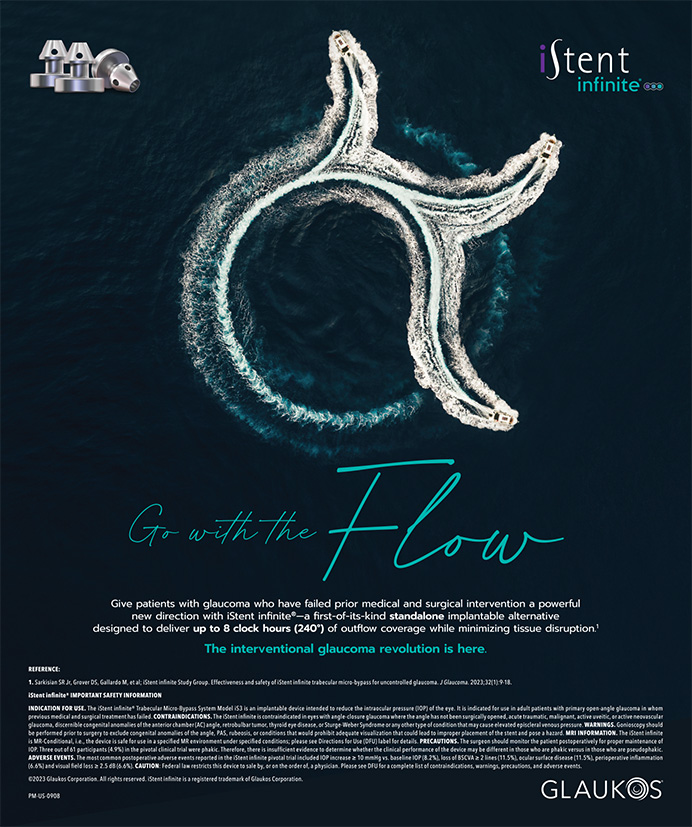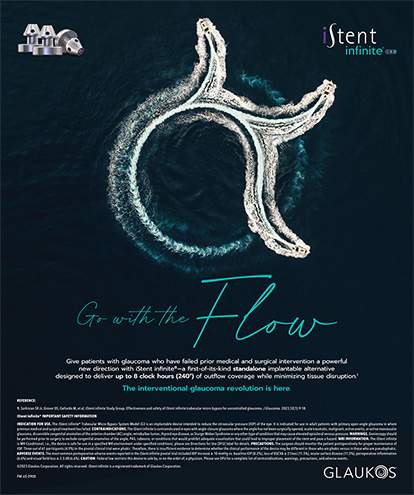The surgical correction of astigmatism was first reported in 1885 by the Norwegian physician Hjalmar Shiotz, who reduced corneal toricity by greater than 12.00 D with a full-thickness corneal incision.1 Almost a century later, in 1979, Thomas Cravy described the importance of surgical planning and controlling postoperative astigmatism.2 Since then, the advent and refinements of modern cataract surgery have resulted in an emphasis on spectacle independence for the increasingly more common refractively minded patient.
FACTORS TO CONSIDER
Although corneal astigmatism can be managed at any point perioperatively, the intraoperative surgical correction of astigmatism via relaxing incisions or with pseudophakic correction using a toric IOL is the obvious choice. Various factors affect how I plan to correct patients' astigmatism. They include the magnitude, steep meridian, and regularity (or irregularity) of the corneal astigmatism; the presence of other corneal comorbidities (ie, pterygium, anterior basement membrane dystrophy, peripheral corneal thinning); and the presence of posterior corneal astigmatism.
The basic tenet of treating corneal astigmatism is to properly identify it from a healthy ocular surface. Corneal epithelial-based pathologies such as punctate keratopathy of dry eye disease, anterior basement membrane dystrophy, and Salzmann nodular dystrophy must be diagnosed and reconciled. Likewise, I caution against treating astigmatism caused by a pterygium unless it is a stable and very peripheral pterygium that minimally encroaches on the corneal surface and does not create a false flattening profile on the simulated keratometric measurements on topography.
HOW TO ACCOUNT FOR ASTIGMATISM
Recent research revealed the importance of posterior corneal astigmatism. This helps to explain why the magnitude of patients' refractive astigmatism does not always align with patients' topographic astigmatism. Koch et al demonstrated that 86.6% of eyes have a vertically oriented steep corneal meridian, and unlike anterior corneal astigmatism, this posterior with-the-rule (WTR) astigmatism does not drift horizontally with age.3 According to optical principles, the posterior cornea acts like a negative lens, so WTR posterior corneal astigmatism functionally behaves like total ocular against-the-rule (ATR) astigmatism. Not accounting for the contributions of the posterior cornea means that, after the implantation of a toric IOL, eyes that have WTR astigmatism are commonly overcorrected with a flipped axis, whereas eyes that have ATR astigmatism very often have residual undercorrection of that cylinder. My colleagues and I validated this theory in a series of toric IOL patients upon evaluating the astigmatic prediction errors produced by five different devices.4 All of the devices overestimated the amount of WTR astigmatism present by approximately 0.50 D. All of the devices that solely evaluated the anterior corneal surface underestimated the amount of ATR astigmatism present by about 0.25 D.
Additionally, Hayashi et al found, over 10 years, an ATR drift of about 0.37 D regardless of the cornea's surgical status.5 This natural shift—over and above posterior corneal astigmatism—has further influenced my refractive target and how I surgically correct corneal cylinder. In general, I aim to leave eyes with slight WTR astigmatism postoperatively. No one device or piece of equipment can accurately measure the magnitude of posterior corneal astigmatism. As a result of our findings, in eyes with WTR astigmatism, I subtract 0.60 D from the topographic astigmatism to account for the average 0.50 D WTR posterior corneal astigmatism, and I undercorrect a little more in order to leave these eyes with some residual WTR astigmatism.
For eyes with ATR astigmatism, I add 0.50 D to the topographic astigmatism to calculate the total refractive ATR astigmatism that I plan to correct. This additional 0.50 D accounts for the average 0.25 D posterior WTR contribution from the posterior cornea (or functionally ocular ATR toricity) as well as a bit more to intentionally flip the axis and leave these eyes with a low degree of WTR postoperative astigmatism.
Other caveats to keep in mind apply to higher levels of WTR astigmatism as well as to short and long eyes. Corneas with high amounts of anterior WTR astigmatism also have large amounts of vertically oriented posterior corneal astigmatism. This does not hold true, however, for ATR posterior corneal astigmatism. I will, therefore, back off my toric IOL power by an additional power in eyes with greater than 3.00 D of WTR astigmatism. Lastly, the effective lens position also affects the magnitude of toric correction provided by a specific toric power, regardless of the meridian of the astigmatism. I will opt for the lower powered toric IOL in short eyes and consider choosing the higher toric power lens in long eyes to account for effective lens position. In general, I follow the Baylor Toric IOL nomogram for IOL selection, which essentially reserves the use of a toric IOL in WTR astigmatism until at least 1.75 D of topographic astigmatism is present, but correspondingly, I use a toric IOL in patients with approximately 0.50 D of ATR topographic astigmatism.
LIMBAL RELAXING INCISIONS
Corneal relaxing incisions, particularly limbal relaxing incisions (LRIs), correct low amounts of corneal astigmatism (< 1.75 D), albeit less predictably than I prefer. In my hands, LRIs correct WTR astigmatism better than ATR astigmatism. This may be because the refractive WTR astigmatism was commonly less than the topographic WTR magnitude. Other reasons for the unpredictability of manual LRIs have included my use of a universal blade with a single preset depth on all corneas and a lack of a consistent optical zone (OZ). Also, the underlying corneal hysteresis likely affects each individual response to any incisional treatment. Although far from an exact science, laser cataract surgery has given me more confidence in the refractive effects of my LRIs. Relaxing incisions created with a laser are titratable postoperatively and can be consistently created at a desired depth and OZ. My personal nomogram (unpublished) takes into account my experience with laser LRIs and posterior corneal astigmatism, and it aims to leave patients with slight WTR astigmatism postoperatively. I use an 80% depth and a 9- to 10-mm OZ, and I opt for a bigger OZ in eyes with large corneas.
MY PREFERENCES
Because toric IOLs are invariably more accurate than LRIs, I prefer to treat preexisting corneal astigmatism with toric IOLs if the amount of WTR astigmatism is 1.70 D or greater and when the amount of oblique astigmatism is 0.75 D or greater or ATR astigmatism is 0.50 D or greater. For lower amounts of WTR astigmatism (≥ 0.75 D), I offer laser LRIs. Because the magnitude of posterior corneal astigmatism cannot yet be quantified well, when deciding between two toric IOL powers, I will often choose the lower and preplace closed laser LRIs. These incisions have a weaker effect when left unaltered, but opening them up 1 month postoperatively as needed to correct any residual mixed astigmatism can maximize their effect. As demonstrated by my personal laser LRI nomogram (Table), I will only go up to paired 50º arc lengths, because I find that longer corneal incisions increase the chance of postoperative dry eye disease. Lastly, I only relax up to 2.50 D of WTR topographic astigmatism with LRIs (in essence, about 2.00 D since the posterior corneal astigmatism counteracts some of the anterior WTR toricity) and upwards of 1.75 D of ATR astigmatism.
CONCLUSION
As technologies evolve, including advances in astigmatic meridian identification and intraoperative aberrometry, astigmatic management will become more precise.
Section Editor Kathryn M. Hatch, MD, practices corneal, cataract, and refractive surgery at Talamo Hatch Laser Eye Consultants in Waltham, Massachusetts, and is a clinical faculty member at the Alpert Warren Medical School of Brown University in Providence, Rhode Island. Dr. Hatch may be reached (781) 890-1023; kmasselam@gmail.com.
Elizabeth Yeu, MD, is in private practice at Virginia Eye Consultants and an assistant professor of ophthalmology at Eastern Virginia Medical School in Norfolk, Virginia. Dr. Yeu may be reached at (757) 622-2200; eyeu@vec2020.com.
- Jaffe NS, Clayman HM. The pathophysiology of corneal astigmatism after cataract extraction. Trans Am Acad Ophthalmol Otolaryngol. 1975;79:615-630.
- Cravy TV. Calculation of the change of corneal astigmatism following cataract extraction. Ophthalmic Surg. 1979;10:38-49.
- Koch DD, Ali SF, Weikert MP, et al. Contribution of posterior corneal astigmatism to total corneal astigmatism. J Cataract Refract Surg. 2012;38(12):2080-2087.
- Koch DD, Jenkins RB, Weikert MP, et al. Correcting astigmatism with toric intraocular lenses: effect of posterior corneal astigmatism. J Cataract Refract Surg. 2013;39(12):1803-1809.
- Hayashi K, Hirata A, Manabe S, Hayashi H. Long-term change in corneal astigmatism after sutureless cataract surgery. Am J Ophthalmol. 2011;151(5):858-865.


